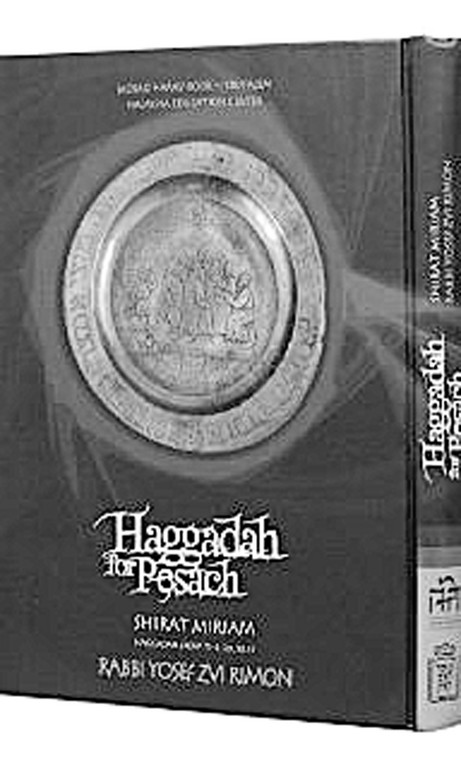The Kosher Bookworm New user friendly Haggadah commentaries
Once again it is my pleasure to bring to your attention several Haggadah commentaries in English that I am certain will enrich both your Seders and your basic knowledge of Pesach purpose, history and ritual.
This past year, Mosad HaRav Kook and the Halacha Education Center in Jerusalem published a new English Haggadah entitled, “Pesach Haggadah Shirat Miriam – Haggadah MiMekorah” for both Ashkenazim and Sefardim by Rabbi Yosef Zvi Rimon of Yeshivat Har Etzion.
This commentary is among the most user friendly comprehensive Haggadot recently published for the English speaking public. In addition, it enjoys approbations from such rabbinic luminaries as Rabbi Aharon Lichtenstein, Rabbi Zalman Nechemiah Goldberg, and Rabbi Simcha Hakohen Kook.
The stellar organization of this work speaks for itself. Given the educational creds of its author, Rabbi Rimon, this volume serves as a virtual beit medrash of Pesach home ritual, dealing with just about every aspect of Haggadah related ritual and purpose, explained for all to comprehend.
A sample of this organizational method can be demonstrated with how the structure of the Haggadah is explained. Utilizing both narrative and graphics, as well as detailed diagrams, Rabbi Rimon presents to us a markedly detailed explanation of both the purpose and reasoning behind just about every detail of the seder service.
This introductory material should be mandated reading for all literate participants starting from Rosh Chodesh Nissan. Assimilating this material will go a long way toward giving the Haggadah a firmer grip upon the attention of most participants. An educated participant makes for a more attentive participant.
This section is followed by a detailed section entitled “Preparations for the Seder,” starting with a detailed descriptive of the seder plate, going into unusual details about the cooked dishes, the types of meat used, a halachic definition of marror and charoset, including the appropriate admonitions concerning checking of the lettuce.
The very placement of the seder plate on the table, the choreography in its handling and use during the service itself is given much attention. Even a veteran of prior seders will surely find much “new stuff” to be learned from Rabbi Rimon’s detailed descriptive.
Consider the detailed explanations concerning the variant placements in the arrangement on the seder plate based upon the opinions of the Vilna Gaon, the Ari, z”l, and the Rama, and the reasoned rationales behind these variants.
Also, for your edification, there is a two page summary that brings together, in classic pedagogic method, all the prior details, giving this section its frame.
“The Stages of the Seder” further reframes the seder ritual, reinforcing all the previous detail with the rubric of “kadeish u’rchatz.” Consider the two page graphs entitled, “Leaning” wherein we are first presented with five questions asking the participant: Why lean? Should one lean nowadays? When can one be more lenient nowadays? When must one lean? How does one lean?
Detailed answers to each, in graph form, are forthcoming. This subject is further reinforced in a variant graphic and summary narrative on the next two pages. Similar graphic and textual methodology is employed with Motzi Matzah, Marror, Korech and Shulchan Orech. Hopefully, someday, these pages will be enhanced into posters for both classroom and adult educational use. Never has Jewish law been given a better demonstration as to its practical purpose and application as has been applied in this work. With this work, Rabbi Rimon has given new definition to the term, “user friendly.”
Rabbi Yosef Zvi Rimon, Mosad HaRav Kook and the Halacha Education Center should be mighty proud of this work. Hopefully, someday soon, this methodology will be applied to our liturgy.
FOR FURTHER STUDY
A timely reprise is in order for a mention of several excellent, previously reviewed Haggadas that were most favorably received by my many readers. The first is entitled, “The Schechter Haggadah: Art, History, and Commentary,” representing a joint collaborative effort by Dr. Joshua Kulp and Rabbi Prof. David Golinkin, both of Jerusalem. It brings together within one self-contained work, the entire Haggadah ritual framed by art representing a historical interpretation of the Pesach experience down through the ages from the Middle ages unto modern times. This is further supplemented by a section of detailed, extremely scholarly, historically based commentary that serves to supplement the halachically based commentary previously cited in Rabbi Rimon’s work.
Another work of the same literary genre previously cited is “Haggadah of the Sages” [Carta, 2009] by Prof. Shmuel Safrai and Prof. Ze’ev Safrai.
This work is an exquisitely compiled compendium of essays detailing the evolutionary process that led to the writing of the Haggadah. As with the other two previously cited books, this work, when taken together with the others, will surely give you a better and deeper appreciation of the Haggadah, its ritual and service. In addition, all three of these valued works will surely give you a better understanding of the place that the Exodus has in both the theology and history of our people.
I am certain that the scholarship presented therein represents a perspective that is not yet taught in most of our secondary schools as experienced by most of you. Hopefully, some day, as this material gets to be further appreciated, this scholarship will increasingly find its way into our community schools and batei medrashim.

 60.0°,
Mostly Cloudy
60.0°,
Mostly Cloudy 







